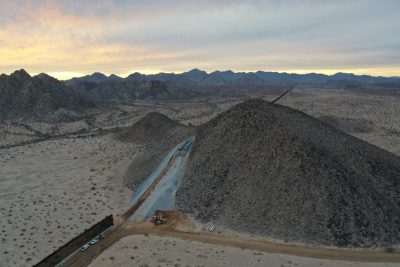UNESCO Urges End to Border Wall Threatening World Heritage Site, Wildlife in Mexico

All Global Research articles can be read in 51 languages by activating the “Translate Website” drop down menu on the top banner of our home page (Desktop version).
Visit and follow us on Instagram at @crg_globalresearch.
***
The UNESCO World Heritage Committee today urged the United States to stop border wall construction. The committee also called on the United States to work with Mexico to assess damage from the wall to a World Heritage site in Mexico and adjacent protected lands in the United States and recommend ways to restore the landscape and wildlife habitat.
Today’s resolution approved by the committee, the official decision-making body under the World Heritage Convention, follows a 2017 petition from conservation groups and representatives of the Tohono O’odham of Sonora, Mexico. That petition sought “in danger” status for El Pinacate and Gran Desierto de Altar Biosphere Reserve on the U.S.-Mexico border. This 2,700-square-mile World Heritage site shares a border with Cabeza Prieta National Wildlife Refuge and Organ Pipe Cactus National Monument in the U.S.
“This is an important step toward repairing the devastation the border wall has done to communities and wildlife,” said Alex Olivera, a senior scientist and the Mexico representative for the Center for Biological Diversity. “We share a responsibility to protect wildlife in the Sonoran desert and reverse the horrific damage wall construction has inflicted on both sides of the border.”
In its resolution, the committee said the “negative impacts of the border wall on the biodiversity and conservation of the property is of utmost concern.” It urged the United States to halt border wall construction between the biosphere reserve, Organ Pipe and Cabeza Prieta, assess the damage and “develop appropriate measures to ensure the restoration of ecological connectivity.”
In 2013 UNESCO designated the El Pinacate Biosphere Reserve as a World Heritage site in recognition of the area’s outstanding biodiversity, including desert wildlife that evolved over millions of years freely crossing the U.S.-Mexico border. The border wall blocks essential movement and migration, fragments habitat and limits animals’ ability to search for food and water.
The wall also harms the Tohono O’odham people, who historically inhabited El Pinacate and Gran Desierto de Altar and whose traditional lands are split by the U.S.-Mexico border. El Pinacate is sacred to the Tohono O’odham, and the site is regularly used for ceremonial purposes, including a sacred salt pilgrimage across the border to the Gulf of California.
President Joe Biden signed an executive order his first day in office that paused border wall construction. In June the administration canceled wall projects paid for with diverted military funds.
Conservation groups have called on the Biden administration to immediately begin restoring more than a dozen ecologically sensitive and culturally significant areas damaged by wall construction, including areas bordering El Pinacate.
The coalition sent the administration and members of Congress a document detailing the criteria and specific areas in Arizona, California, New Mexico and Texas where the wall should come down and the land allowed to heal. These include wildlife refuges, sacred sites, wilderness areas, wildlife corridors and rivers.
“Restoring these fragile ecosystems must be a binational effort, and we’re grateful UNESCO has stepped up so powerfully to address this,” said Olivera. “We’re hopeful the Biden and Lopez Obrador administrations will work closely with border communities and tribal nations to repair all that’s been destroyed.”
*
Note to readers: Please click the share buttons above or below. Follow us on Instagram, @crg_globalresearch. Forward this article to your email lists. Crosspost on your blog site, internet forums. etc.
Featured image: Border-wall construction blasts through the Cabeza Prieta Wildlife Refuge and Pinacate Y Gran Desierto de Altar Biosphere Reserve. Photo credit: Russ McSpadden, Center for Biological Diversity

